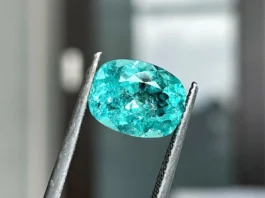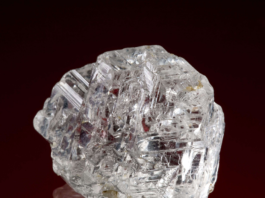The Pink Star Diamond is a truly remarkable and exceedingly rare gemstone that has captured the attention of collectors, investors, and enthusiasts around the world. Renowned for its exceptional color and size, this diamond stands as a testament to the Earth’s geological forces and the incredible beauty that can result from millions of years of natural processes.


The Pink Star Diamond’s significance lies not only in its extraordinary aesthetic qualities but also in its rarity. Colored diamonds, also known as fancy colored diamonds, are already quite uncommon in comparison to their colorless counterparts. Among these colored diamonds, pink diamonds are among the rarest, making the Pink Star Diamond a true treasure of the gem world.
What sets the Pink Star Diamond apart is its unparalleled color saturation and vibrancy. The diamond exhibits an exquisite pink hue that is incredibly vivid and intense, captivating anyone who gazes upon it. This remarkable coloration is a result of specific conditions and trace elements present during the diamond’s formation, which we’ll delve into shortly.
Furthermore, the Pink Star Diamond boasts an impressive size, adding to its allure. Its substantial carat weight is a testament to the diamond’s unique combination of size and color, creating a mesmerizing gemstone that is unparalleled in its beauty.
The geological factors that contributed to the formation of the Pink Star Diamond are a fascinating aspect of its story. Diamonds are formed deep within the Earth’s mantle under immense heat and pressure. The presence of certain elements, such as boron, during this formation process can lead to the creation of pink diamonds. The precise combination of these geological conditions is what gives rise to the Pink Star Diamond’s stunning color and rarity.
In essence, the Pink Star Diamond is a product of the Earth’s intricate and dynamic geological processes, a rare masterpiece that showcases the harmonious interplay of natural forces resulting in a breathtaking gem of unparalleled beauty, size, and color.
Contents
Diamond Formation and Origin

Diamonds, including the Pink Star Diamond, are formed through a remarkable natural process that takes place deep within the Earth’s mantle under conditions of high pressure and temperature. This process involves the crystallization of carbon atoms into the well-known diamond structure.
Under immense pressure and heat, carbon atoms arrange themselves into a tight, three-dimensional lattice structure, which gives diamonds their exceptional hardness and brilliance. This process takes place at depths of around 150 to 200 kilometers (about 93 to 124 miles) below the Earth’s surface.
One of the key geological features associated with diamond formation is kimberlite. Kimberlite is a type of volcanic rock that originates from even deeper within the Earth’s mantle. It is believed that diamonds form within these kimberlite-rich regions and are brought to the surface during volcanic eruptions.
Kimberlite pipes are vertical columns of kimberlite rock that have erupted from the Earth’s mantle to the surface. These eruptions are incredibly powerful and can carry diamonds and other minerals from deep within the Earth to the surface in a relatively short period of time. As the kimberlite material cools and solidifies, it forms distinct geological formations known as kimberlite pipes.
The Pink Star Diamond’s geological origin is likely associated with a specific kimberlite pipe and the surrounding geological region. While the exact location of its origin might not be publicly disclosed, pink diamonds, in general, have been known to come from several regions around the world, including Australia, Africa (notably the Argyle mine in Australia and various mines in southern Africa), and Brazil, among others.
If the Pink Star Diamond’s origin were known, it could potentially be traced back to a specific mine or kimberlite pipe within one of these regions. The formation of the Pink Star Diamond and its subsequent journey to the Earth’s surface provide a fascinating glimpse into the dynamic processes that shape our planet and give rise to some of its most precious and captivating treasures.
Geological Factors Affecting Color

The color of diamonds, including the Pink Star Diamond, is influenced by a range of geological factors that occur during their formation deep within the Earth’s mantle. These factors play a crucial role in determining the unique and vibrant hues that diamonds can exhibit. Here are some of the key geological factors that affect a diamond’s color:
- Presence of Trace Elements: One of the primary contributors to a diamond’s color is the presence of trace elements within the carbon lattice structure. Different elements can impart various colors to the diamond. For instance, nitrogen can cause a diamond to appear yellow or brown, while boron can give rise to blue hues. In the case of pink diamonds like the Pink Star, it is believed that the presence of a specific type of defect, known as a “plastic deformation,” within the crystal lattice causes the absorption of certain wavelengths of light, resulting in the pink coloration.
- Pressure and Depth of Formation: Diamonds that form deeper within the Earth’s mantle under higher pressures can exhibit different colors due to variations in crystal structure and the way light interacts with the carbon lattice. The intense pressures at these depths can lead to unique color outcomes.
- Geological Surroundings: The geological environment in which diamonds form can impact their color. Different minerals and conditions in the surrounding rock can influence the growth and coloration of diamonds. Kimberlite, the volcanic rock that often hosts diamond-bearing pipes, can contribute to color through interactions between the diamond and the kimberlite material.
- Tectonic and Geological Events: The movement of tectonic plates and geological events can affect a diamond’s color by exposing it to different conditions as it moves towards the Earth’s surface. These events can influence the diamond’s growth and the incorporation of trace elements, ultimately influencing its color.
- Crystal Growth and Strain: The way a diamond crystal grows and any internal strain it experiences during its formation can impact its color. Distortions in the crystal lattice caused by growth anomalies or pressure can lead to color variations.
- Radiation Exposure: In some cases, diamonds can be exposed to natural radiation from nearby radioactive minerals during their formation. This radiation can alter the color of the diamond over time.
The interplay of these geological factors creates a spectrum of colors in diamonds, ranging from colorless to various shades of yellow, brown, pink, blue, and more. The Pink Star Diamond’s exquisite pink color, for instance, is a result of specific geological conditions and trace elements that influenced its formation. This captivating interplay between geology and chemistry gives each diamond its unique and stunning appearance, making them some of the most treasured gems on Earth.
Gemological Characteristics of Pink Star Diamond

- Color: Pink diamonds are known for their exceptional and vibrant pink color. The intensity and hue of the pink can vary widely, ranging from pale and delicate pastel pinks to vivid and saturated shades. The Pink Star Diamond, as a notable pink diamond, would likely exhibit a highly prized and intense pink color.
- Clarity: Clarity refers to the presence of internal or external imperfections, known as inclusions and blemishes, within a diamond. Pink diamonds, like all diamonds, can have varying degrees of clarity. Some pink diamonds might have minimal inclusions, while others could have visible internal characteristics. Clarity does impact a diamond’s value, but in the case of colored diamonds like the Pink Star, the color often takes precedence.
- Cut and Shape: The cut of a pink diamond, or any diamond, plays a significant role in its overall appearance and brilliance. Pink diamonds are cut to maximize their color and potential for light dispersion, creating a balance between color saturation and brilliance.
- Carat Weight: Carat weight measures the size of a diamond and is a significant factor in determining its value. The Pink Star Diamond, being a prominent and highly prized gem, would likely have a substantial carat weight.
- Fluorescence: Fluorescence refers to a diamond’s reaction to ultraviolet (UV) light. Some pink diamonds may exhibit fluorescence, which can influence their appearance under different lighting conditions.
- Origin: The origin of a pink diamond can influence its value and rarity. Pink diamonds have been found in various locations, with notable sources being the Argyle mine in Australia and some mines in Africa and Brazil. The Pink Star Diamond’s specific origin would contribute to its unique story and characteristics.
- Treatment: Some pink diamonds, like other colored diamonds, may undergo treatments to enhance their color or clarity. Disclosure of any treatments is important for transparency in the gem trade.
- Inclusions and Unique Features: Pink diamonds can exhibit distinctive inclusions, growth patterns, or features that make each stone unique. These characteristics contribute to the diamond’s individuality and beauty.
It’s important to note that each pink diamond is unique, and gemological characteristics can vary widely even within the same color category. The Pink Star Diamond, as a rare and renowned pink diamond, would likely possess exceptional qualities that make it a truly remarkable and highly coveted gemstone.
Distribution and Mining Locations

The Pink Star Diamond was originally mined in South Africa. It weighed 132.5 carats in its rough form when it was discovered in the early 1990s. The diamond’s remarkable size and exquisite pink color immediately made it a highly sought-after and unique gemstone.
In 2013, the Pink Star Diamond was cut and polished into its current oval shape, weighing 59.60 carats. It was auctioned by Sotheby’s in Geneva, Switzerland, in April 2017. The auction marked a historic moment in the diamond industry, as the Pink Star Diamond became the most expensive gemstone ever sold at auction, fetching a record-breaking price of over $71 million.
The buyer of the Pink Star Diamond was Hong Kong-based jewelry retailer Chow Tai Fook, a company known for its significant investments in rare and valuable diamonds.
- Argyle Diamond Mine (Australia): The Argyle mine in Western Australia has been one of the most significant sources of pink diamonds. It has produced a substantial portion of the world’s pink diamonds, including many of the most famous and valuable pink diamonds. The mine has been known for its unique and intense pink diamonds, often referred to as “Argyle Pink Diamonds.”
- Mines in Africa: Various mines in Africa, particularly in countries like South Africa and Tanzania, have also yielded pink diamonds. While not as prolific as the Argyle mine, these African mines have produced some noteworthy pink diamonds.
- Brazil: Pink diamonds have been found in Brazil, where the country’s rich geological history has contributed to the formation of colored diamonds, including pinks.
- Other Sources: Pink diamonds have been found in smaller quantities in other locations around the world, but these sources are generally less significant compared to the aforementioned regions.
It’s important to note that pink diamonds are extremely rare regardless of their source, and their availability can fluctuate over time. The Argyle Diamond Mine, which was one of the primary sources of pink diamonds, ceased its operations in late 2020, further emphasizing the rarity of these gemstones.






